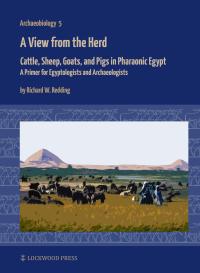A View from the Herd: Cattle, Sheep, Goats, and Pigs in Pharaonic Egypt
Synopsis
In this book, the late Richard Redding synthesizes his decades-long work on the ancient agricultural economy of Egypt. Drawing on a diverse range of data, including zooarchaeology, ancient texts, and iconographic sources, he explores the role of cattle, sheep, goats, and pigs in the economic infrastructure of ancient, mainly pharaonic, Egypt and the complexities of decision-making processes that shaped the use and management of these vital livestock resources.
The book integrates zooarchaeological and historical data with information on unimproved breeds of cattle, sheep, goats, and pigs from Egypt and the broader Middle East as well as considers texts and tomb paintings. Redding argues that understanding the interplay between economic forces, environmental factors, and herders’ knowledge of animal characteristics is crucial for unraveling the dynamic nature of decision-making. The author explores herd growth rates, meat yields, caloric and nutritional benefits, and optimal herd structures. By employing that data and ecological models, including the annual Nile floods, he provides insights into the adaptive strategies employed by ancient Egyptian herders. In this way, Redding examines the economic rationale behind ancient Egyptian herding communities. His models of pharaonic herding strategies generate expectations tested using zooarchaeological evidence.
Redding long advocated the modeling approach he demonstrates here, understanding zooarchaeological data through a lens of animal biology and environmental context. This work should therefore spark wide interest among archaeologists working in disparate regions.
Chapters
-
Front Matter
-
1. The Importance of Cattle, Sheep, and Goats; Decision-Making in Ancient Egypt; and a Little Theory
-
2. Taxonomy and Nomenclature
-
3. The Origin of Domestic Cattle, Sheep, and Goats in Egypt
-
4. Environmental FactorsFloods, Rains, and Climate Change
-
5. The Ecological Biogeography of Pastoralism in Ancient Egypt
-
6. Feeding and Foddering
-
7. Herd Size in Ancient Egypt
-
8. The AssumptionsA Framework for Modeling Animal Management in Ancient Egypt; Pulling It All Together
-
9. The Baladi BreedA Model for Cattle in Ancient Egypt
-
10. Modeling Pharaonic Cattle Management and Productivity
-
11. Unimproved Breeds of SheepA Model for Pharaonic Sheep
-
12. Unimproved Breeds of GoatsA Model for Pharaonic Goats
-
13. Modeling Pharaonic Sheep and Goat Management and Productivity
-
14. The Pig in Ancient Egypt
-
15. Comparing Cattle, Sheep, Goats, and PigsPredictions and Two Normative Assumptions Reexamined
-
16. Butchering, Nutrition, and Patterns of Consumption
-
17. Archaeological Data from the Old KingdomPatterns and Explanations
-
Bibliography (included with each chapter)
-
Index


